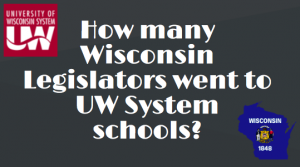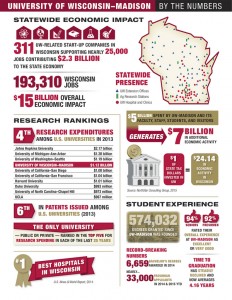by Andrew Tucker
With Wisconsin’s yearly tax revenue confirmed to be coming in around previous estimates, the cuts to the UW System proposed three months ago by Scott Walker will likely stay the same.
Over the last few months, the main issue being discussed in Wisconsin political circles has been Scott Walker’s proposed biennium budget and the proposal to cut $300 million from the UW System over the next two years. Whether the cuts are right or wrong may depend on one’s political leaning. Regardless of whether people are blue or red, the cuts will impact the campuses and their surrounding communities immensely.

The first tangible results of the cuts are already seeping into campus life. On April 10, UW Board of Regents passed a measure that would raise out-of-state tuition by $6000 over the course of the next two school years. This is an attempt to bridge the gap created by the cuts, but it also may cause out-of-state students to become privileged because of the tuition freeze in effect for in-state students.
Currently, there is a cap in place that limits the out-of-state students to make up only 27.5% of each freshman class. This went up two years ago from the long held cap of 25%. Chancellor Blank has not yet specifically requested the cap be raised to 30%, but University of Wisconsin-Madison professor and Wisconsin Center for the Advancement of Postsecondary Education (WISCAPE) Director Noel Radomski believes the request going to come before the next school year.
WISCAPE is a research center that collaborates with researchers, policymakers, business leaders and the media in researching trends in postsecondary (college and university) education, as well as proposing courses of action to the leaders of such institutions.
While most of the discussion of the cuts has centered around how it will affect the prestige of UW-Madison, Radomski believes that the trouble with the cuts will lie elsewhere.
“I think the biggest impact is the UW colleges, because they are so dependent on tuition and state revenue, whereas you look at a place like UW-Madison, we get $1 billion in federal grants, we get $80 million from the Wisconsin Alumni Research Foundation (WARF) endowment, and obviously the UW foundation gives millions of dollars,” Radomski said.
The colleges Radomski is referring to includes the many 2 year and technical colleges in the UW System, as well as the smaller 4 year schools like UW-Superior and UW-Parkside. While UW-Madison will carry most of the burden of the cuts, the smaller schools have less of a student and alumni base to rely on for support, which is leading to cutting programs and shrinking support staffs for schools that often accept students in need of at least some academic support.
While the effects of this cut will be felt for years in the state, this result isn’t necessary according to Democrat Chris Taylor, who represents Wisconsin’s 76th District in the State Assembly.
“We don’t need to cut the university, we don’t need to make any of these cuts,” Taylor said. “The fact of the matter is Republicans made bad, bad decisions. They gave away $1.9 billion in tax cuts over their tenure, to a lot of people who didn’t need them, frankly.”
Taylor pointed to a tax credit in this biennium budget, the Manufacturers and Agricultural Tax Credit that is totaling $226 million. That money would cover about 70% of the UW System cut if eliminated.

Republican Speaker of the Assembly Robin Vos’ office was contacted for comment on these claims, but did not respond.
Taylor says that her work on the Joint Finance Committee had her travelling around the state, meeting with constituents at forums and town-hall style events. She claims nobody spoke in favor of the cuts at these events, only against. Alongside that, Taylor says she has trouble seeing who benefits from the cuts.
“It’s very hard to see. It has to be the private schools that it helps, I don’t know who it helps,” Taylor said. “It doesn’t help the people of the state of Wisconsin, perhaps it helps Governor Walker’s presidential ambitions with the right-wing of his party.”
Walker’s presidential ambitions have been no secret since being reelected last fall, with many speculating him throwing his hat in the ring, while he has not officially declared his candidacy at the time of publishing this article. In preparation for potential party pandering, Radomski took a look at the educational systems of states in similar situations of Republican governors with presidential ambitions to see how they have responded.
“I looked to see what’s going on in Texas because of Perry, Christie in NJ, Kasich in Ohio, Scott in Florida because Jeb Bush was there prior to that. So those are usually pretty good indicators of what may happen here,” Radomski said. “What’s going on in those states is they’re jacking up both non-resident tuition, but also the number [of non-resident students]. The other piece of what’s going on is they’re hiring more non-tenured faculty.”
With those being likely outcomes of cuts, the Wisconsin Idea seems like it may be in danger, or at least it may need to adapt. The inclusion of more out-of-state students would jeopardize the Wisconsin Idea’s goal of educating the state’s youth, and the inclusion of more non-tenured faculty would likely mean less tenured faculty, putting the university’s standing as a top research university in jeopardy as well, another key component of the Wisconsin Idea. Already the dean of the College of Agriculture and Life Science (CALS) Kathryn VandenBosch has warned of closing the university’s agricultural experimental research stations. These facilities are embodiments of the Wisconsin Idea that existed for more than a decade before the Wisconsin Idea was officially put into writing in 1904.
Taylor also worries about the future of the Wisconsin Idea, saying that policymakers at the capital may not understand exactly what it means, and that the university and the capitol should try to bridge the gap.
“They’re doing all kinds of things that advance the interest of everybody in the state, regardless of whether you attend or not, regardless of whether you have a child who attends or not. I think we’re unique in the whole nation for that emphasis; it’s not just educating our kids, it’s improving our communities and improving our state,” Taylor said.
For more information on the topic, click here.
